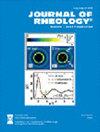Viscosity experiments of slag-spinel suspensions: The effect of volume fraction, particle size, and shear rate
IF 3.2
2区 工程技术
Q2 MECHANICS
引用次数: 0
Abstract
Heterogeneous slag viscosity measurements have a wide variety of parameters, such as particle size, shape, solid volume fraction, and shear rate, which affect the final measured viscosity. Often, some of these parameters are neglected or predicted via models, since it is experimentally difficult to determine them during high-temperature slag viscosity measurements. In this work, a viscosity apparatus was used, which allows quenching of the sample after measurement. This way, all relevant parameters could be experimentally determined. The viscosities of three datasets were studied with various spinel sizes: small (13 μm), medium (34 μm), and large particles (76 μm). Within each dataset, the composition of the liquid slag matrix was kept constant to uniquely measure the effect of solids. Shear thinning, i.e., a decreasing viscosity with increasing shear rate, was observed for all samples, even at a low vol. % of 1.8. Moreover, stronger shear thinning was observed at a higher vol. % and for smaller spinel particles. On the basis of these results, the phenomenon of shear thinning was discussed and mainly attributed to the particle–particle orientation in the suspension. The obtained viscosity values were used to optimize a Krieger–Dougherty equation, which describes the viscosity increase caused by the presence of a certain vol. % of spinel particles, with a certain size and at a specific shear rate.渣尖晶石悬浮液粘度实验:体积分数、粒度和剪切速率的影响
非均质炉渣粘度测量有各种各样的参数,如粒度、形状、固体体积分数和剪切速率,这些参数都会影响最终测量的粘度。通常,由于在高温炉渣粘度测量过程中难以通过实验确定这些参数,因此其中一些参数被忽略或通过模型预测。在这项工作中,使用了粘度仪,它允许在测量后对样品进行淬火。这样,所有相关参数都可以通过实验确定。研究了尖晶石粒径为小(13 μm)、中(34 μm)和大(76 μm)的3个数据集的粘度。在每个数据集中,液态渣矩阵的组成保持不变,以独特地测量固体的影响。剪切变薄,即粘度随着剪切速率的增加而降低,在所有样品中都观察到,即使在低体积% 1.8时也是如此。此外,在较高的体积%和较小的尖晶石颗粒下,观察到更强的剪切变薄。在此基础上,讨论了悬浮液的剪切变薄现象,认为剪切变薄的主要原因是悬浮体中的颗粒-颗粒取向。得到的粘度值用于优化Krieger-Dougherty方程,该方程描述了一定体积百分比的尖晶石颗粒在一定尺寸和特定剪切速率下的粘度增加。
本文章由计算机程序翻译,如有差异,请以英文原文为准。
求助全文
约1分钟内获得全文
求助全文
来源期刊

Journal of Rheology
物理-力学
CiteScore
6.60
自引率
12.10%
发文量
100
审稿时长
1 months
期刊介绍:
The Journal of Rheology, formerly the Transactions of The Society of Rheology, is published six times per year by The Society of Rheology, a member society of the American Institute of Physics, through AIP Publishing. It provides in-depth interdisciplinary coverage of theoretical and experimental issues drawn from industry and academia. The Journal of Rheology is published for professionals and students in chemistry, physics, engineering, material science, and mathematics.
 求助内容:
求助内容: 应助结果提醒方式:
应助结果提醒方式:


